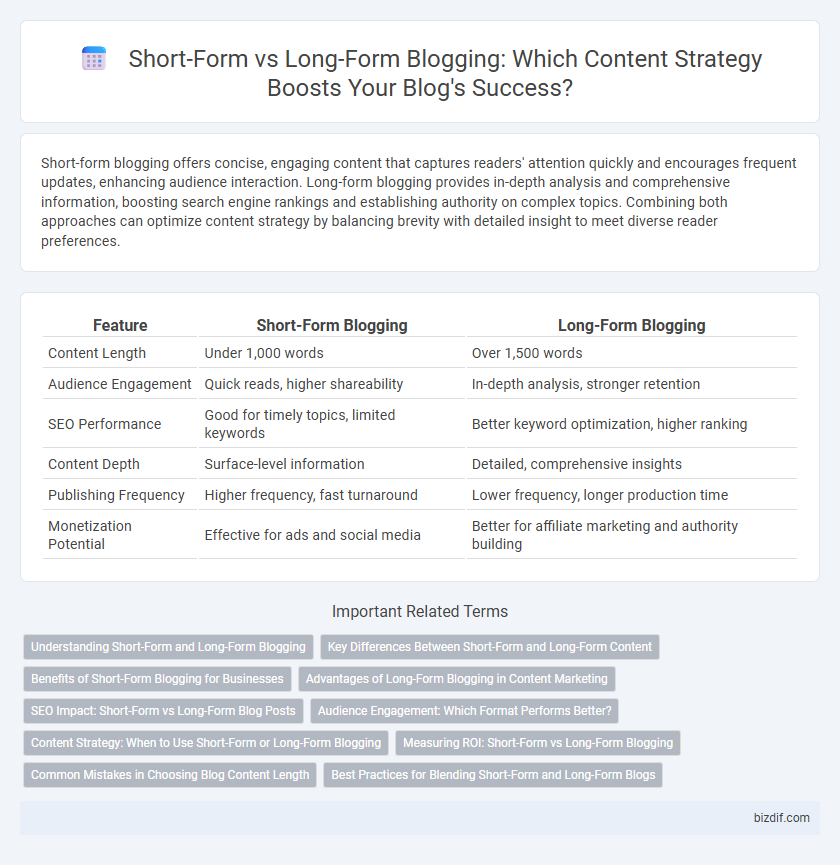Short-form blogging offers concise, engaging content that captures readers' attention quickly and encourages frequent updates, enhancing audience interaction. Long-form blogging provides in-depth analysis and comprehensive information, boosting search engine rankings and establishing authority on complex topics. Combining both approaches can optimize content strategy by balancing brevity with detailed insight to meet diverse reader preferences.
Table of Comparison
| Feature | Short-Form Blogging | Long-Form Blogging |
|---|---|---|
| Content Length | Under 1,000 words | Over 1,500 words |
| Audience Engagement | Quick reads, higher shareability | In-depth analysis, stronger retention |
| SEO Performance | Good for timely topics, limited keywords | Better keyword optimization, higher ranking |
| Content Depth | Surface-level information | Detailed, comprehensive insights |
| Publishing Frequency | Higher frequency, fast turnaround | Lower frequency, longer production time |
| Monetization Potential | Effective for ads and social media | Better for affiliate marketing and authority building |
Understanding Short-Form and Long-Form Blogging
Short-form blogging typically ranges from 300 to 600 words, focusing on quick, concise updates that capture readers' attention and encourage immediate engagement. Long-form blogging exceeds 1,200 words and provides in-depth analysis, detailed explanations, and comprehensive coverage of topics, enhancing SEO through targeted keywords and increased dwell time. Understanding the strengths of both formats enables bloggers to strategically balance content for audience retention and search engine visibility.
Key Differences Between Short-Form and Long-Form Content
Short-form blogging typically ranges from 300 to 600 words and emphasizes quick, digestible insights, ideal for capturing attention in fast-paced online environments. Long-form blogging, often exceeding 1,200 words, provides in-depth analysis, comprehensive coverage, and detailed explanations that boost SEO performance and establish authority. Key differences include depth of content, reader engagement duration, and potential for keyword integration, influencing content strategy based on target audience and marketing goals.
Benefits of Short-Form Blogging for Businesses
Short-form blogging enhances audience engagement by delivering concise, easily digestible content that caters to busy readers and encourages quicker interactions. It supports higher posting frequency, which can improve search engine rankings and maintain consistent brand visibility. This approach also reduces content production time and costs, allowing businesses to allocate resources efficiently while still driving traffic and generating leads.
Advantages of Long-Form Blogging in Content Marketing
Long-form blogging enhances content marketing by providing in-depth information that engages readers and boosts search engine rankings through extensive keyword integration and comprehensive topic coverage. It promotes higher user retention rates and encourages social sharing by addressing multiple facets of a subject in a single post. This format establishes authority and trust, increasing the likelihood of attracting backlinks and improving domain authority.
SEO Impact: Short-Form vs Long-Form Blog Posts
Long-form blog posts, typically over 1,200 words, tend to rank higher in search engine results due to their comprehensive coverage of topics and ability to incorporate multiple keywords naturally. Short-form posts, usually under 600 words, provide quick, focused information and can drive higher engagement on social media but may lack the depth preferred by search algorithms. Combining long-form content for SEO authority with concise short-form posts for user engagement creates a balanced blogging strategy that maximizes online visibility.
Audience Engagement: Which Format Performs Better?
Short-form blogging drives higher audience engagement by catering to readers' limited attention spans and encouraging quick interactions through concise, easily digestible content. Long-form blogging, however, fosters deeper engagement by providing comprehensive information that builds trust and authority, appealing to readers seeking detailed insights. Balancing both formats optimizes reach and sustains diverse audience preferences across platforms.
Content Strategy: When to Use Short-Form or Long-Form Blogging
Short-form blogging excels for quick updates, news, or engaging social media snippets, driving frequent audience interaction and improving SEO through regular content delivery. Long-form blogging is ideal for in-depth tutorials, comprehensive guides, and evergreen content that establishes authority and encourages longer site visits. Choosing between short-form and long-form depends on target audience preferences, content goals, and available resources for content creation.
Measuring ROI: Short-Form vs Long-Form Blogging
Measuring ROI in short-form blogging often reveals faster audience engagement and quicker content production, resulting in immediate but smaller traffic spikes. Long-form blogging typically generates higher long-term ROI by improving search engine rankings, increasing dwell time, and attracting backlinks that enhance domain authority. Analyzing metrics such as conversion rates, average session duration, and backlink profiles helps determine which format yields better returns based on specific marketing goals.
Common Mistakes in Choosing Blog Content Length
Choosing between short-form and long-form blogging often leads to common mistakes such as neglecting audience needs and failing to align content length with SEO goals. Marketers frequently underestimate the value of long-form content in building authority or overusing short-form posts that lack depth and engagement. Optimal blog content length requires balancing reader intent, keyword targeting, and maintaining quality to maximize traffic and conversion rates.
Best Practices for Blending Short-Form and Long-Form Blogs
Effective blogging leverages the strategic blend of short-form and long-form content to maximize audience engagement and SEO performance. Short-form blogs excel at delivering concise, timely updates, while long-form posts provide in-depth analysis and comprehensive insights, establishing authority and improving search rankings. Integrating both formats by linking short-form posts to detailed long-form articles enhances user experience, drives traffic, and boosts content relevance in search engines.
Short-Form Blogging vs Long-Form Blogging Infographic

 bizdif.com
bizdif.com